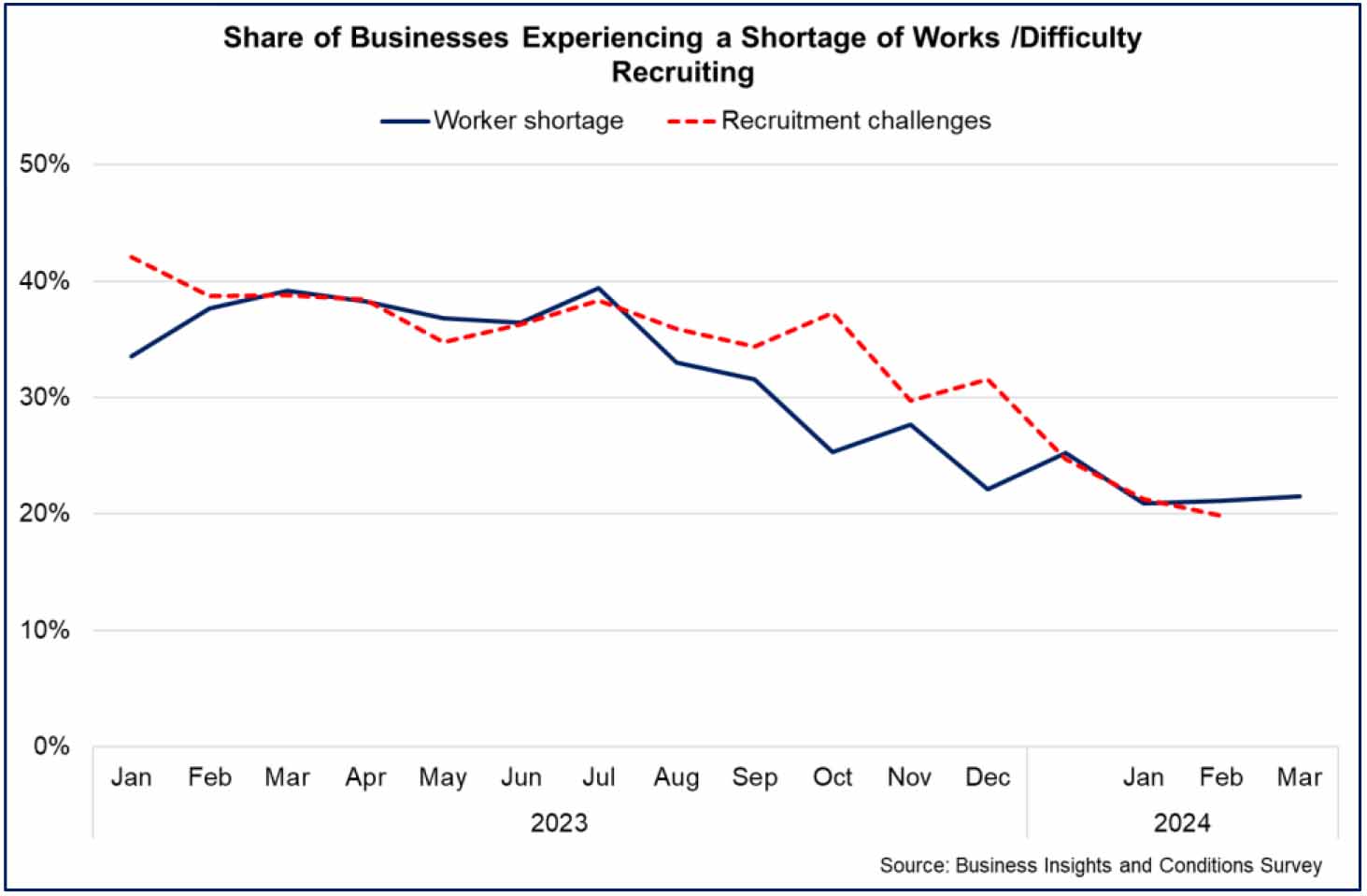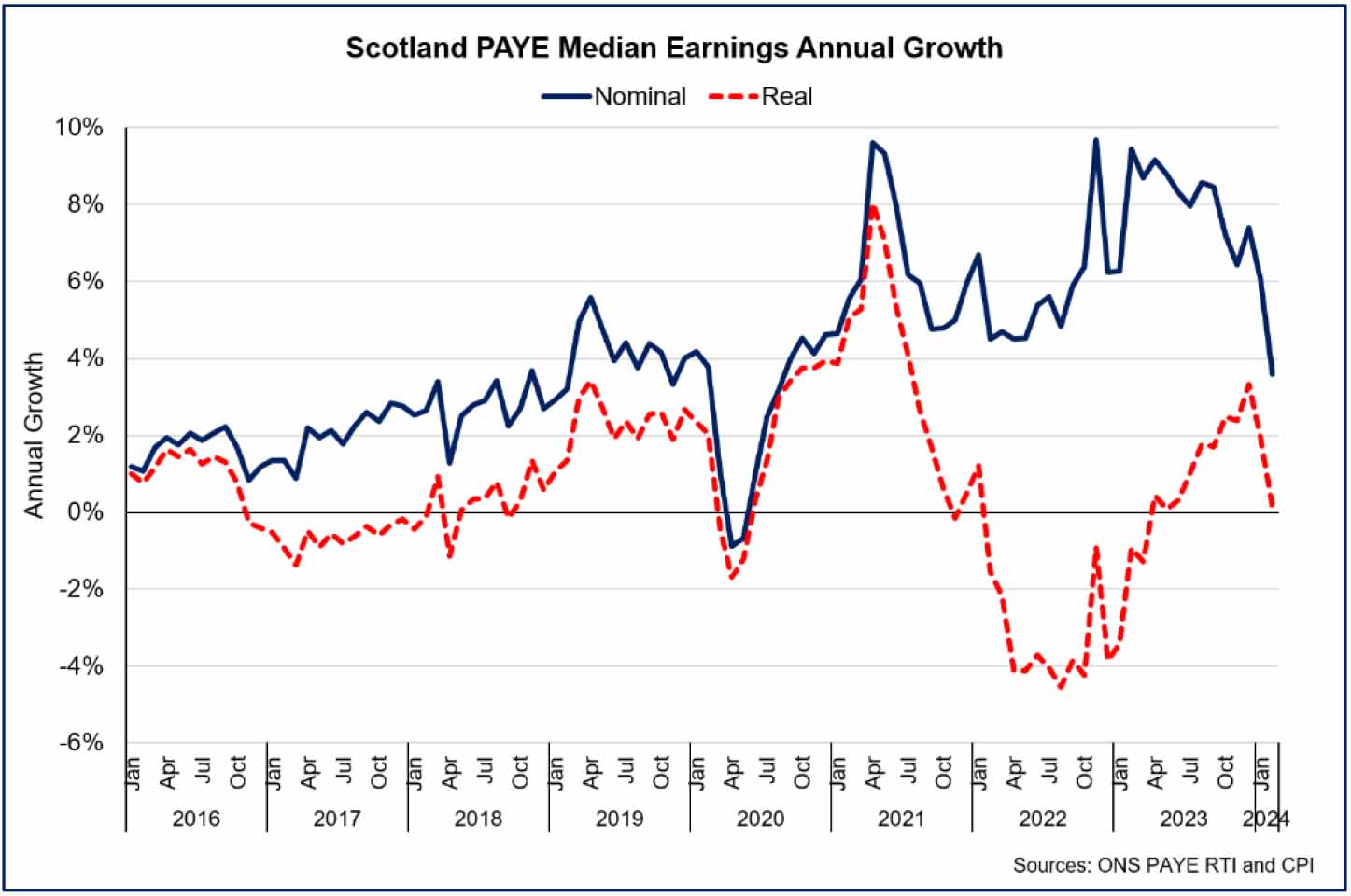Scottish economic bulletin: April 2024
Provides a summary of latest key economic statistics, forecasts and analysis on the Scottish economy.
Labour Market
Payrolled employees remain at a near record high in February however recruitment activity continues to slow.
Employment, Unemployment, and Inactivity
- Scotland’s labour market has remained resilient at the turn of the year in the face of subdued GDP growth and inflationary pressures. Latest data for November to January show that Scotland’s unemployment rate fell 0.3 percentage points over the quarter to 4.1%, while the employment rate rose by 0.4 percentage points to 74.2%, and inactivity rate fell by 0.2 percentage points to 22.5%.[8]

- The labour market has softened slightly over the last year with the employment rate falling 1.7 percentage points while the unemployment has increased 0.8 percentage points, and the inactivity rate has risen 1.1 percentage points. Despite the uncertainties around the ONS’s Labour Force Survey data, wider labour market data continues to illustrate the underlying resilience. In February the number of payrolled employees in Scotland edged down slightly over the month to 2.46 million but remains close to its series high. Alongside this, Scotland’s claimant count rate remained stable in February at 3.5% with the number of claimants falling 0.6% over the month to 105,800, its lowest level since April 2019.[9],[10]

Recruitment Activity
- The softening in labour market conditions over the past year has been accompanied by a slight cooling in the extent of labour market tightness in recent months. The RBS Report on Jobs indicated a sharpening fall in permanent staff placements in February (41.1) as business demand for permanent staff fell for a seventh consecutive month (42.5).[11]

- The survey also indicates that while there has been a slight easing in labour market tightness over the past year, there have been slightly sharper falls at the start of the year in permanent staff availability (supply) indicating that recruitment conditions remain challenging. Furthermore, the Scottish Chambers of Commerce Quarterly Economic Indicator for Q1 2024 indicated that labour market concerns have increased over the quarter with 47% of businesses reporting recruitment challenges (up from 40% in Q4 2023), with challenges particularly in the construction and manufacturing sectors.
- BICS data provides further insights on labour shortages and recruitment challenges. In March, 21.5% of businesses reported experiencing a shortage of workers, down from the average rate of 34% at the start of 2023, while 19.8% of businesses reported experiencing difficulties recruiting in February, down from 42.1% in January 2023.

- At a sector level, worker shortages in March were most reported in construction (35.1%), health and social work (26.7%) and professional, scientific, and technical activities (25.8%). Most recently at the start of February, 60% of businesses reported that worker shortages led to employees working increased hours, while 40% reported being unable to meet demands and 33% reported having to recruit temporary workers.
- Recruitment difficulties in February were most reported in construction (34.1%) and manufacturing (27%). Latest data from January show most businesses responded that a lack of qualified applicants (63.1%) alongside a low number of applications (49.1%) were reasons why they experienced difficulties in recruiting employees while 20.1% reported not being able to afford an attractive pay package for applicants.
Earnings
- Recruitment challenges, staff shortages and inflationary pressures generated upward pressure on earnings growth over the past 18-months, however the pace of growth has recently eased.
- The RBS Report on Jobs for February indicated that growth in starting salaries picked-up over the month (59.7), with respondents attributing this to a shortage of candidates with the necessary skills, however the overall pace of growth has significantly slowed compared to the start of 2023 and during 2022.
- More broadly, nominal median monthly PAYE pay in Scotland was £2,341 in February, down 0.6% over the month and up 3.6% over the year. This is below the average annual growth rate over the past eight years (4.2%), having slowed from higher rates of growth of around 9% in 2023 and is its lowest annual rate of growth since August 2020.[12]

- Adjusting for inflation, which was 3.4% in February, real median earnings grew 0.1% on an annual basis. Whilst marginal, this was the eleventh consecutive month of positive annual growth following the period of falling real pay during 2022 and the start of 2023.
Contact
Email: OCEABusiness@gov.scot
There is a problem
Thanks for your feedback